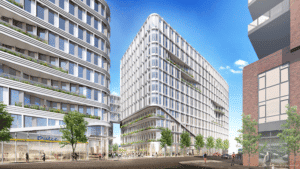
The Druker Co. recently unveiled its designs for a 588,000-square-foot life science complex to replace a vacant industrial property across Washington Street the Ink Block development in Boston’s South End. Image courtesy of Elkus Manfredi Architects
Boston is heavily dependent on property taxes to pay its bills, from keeping police on the streets to filling potholes.
New development plays a crucial role, with the city’s construction boom having kept its tax base – and revenue – growing year after year.
Now, with housing development having fallen sharply and new office plans pretty much off the table amid the remote work debate, lab buildings are shouldering most of the load, city stats show.
The amount of new commercial space, mostly lab, that got a green light from City Hall jumped in 2022, with the same trends appearing to spill over into the first two months of 2023, according to stats from the Boston Planning & Development Agency.
Whether demand for lab space can continue to fuel new development remains to be seen, with the life sciences sector having cooled significantly from its fevered peak of activity back in late 2021.
That said, there is also no sign that Boston’s importance in the global life science ecosystem has taken a hit or is endangered in any way, said Jeff Myers, research director at Colliers in Boston.
“If you look at the outlook for the life sciences sector in the Boston market, it really has convinced a lot of investors that long-term, this is the place to be,” Myers said.
Labs By the Numbers
The BPDA gave its stamp of approval to 5.14 million square feet of new commercial development in 2022.
That was up by more than 1 million square feet compared to 2021.
It was not just approvals, more of a forward-looking measure, that were up in 2022. Construction starts also rose significantly last year.
Developers broke ground on 5.4 million square feet of new commercial space in 2022, totaling $4.6 billion, compared to $1.4 billion and roughly 3.5 million square feet in 2021, according to the BPDA.
By contrast, housing approvals and permits for new units both plunged in 2022, while the office market actually went into negative territory thanks to developers coming back to the BPDA board seeking permission to switch out the offices in their proposals and replace them with labs.
So, does that mean that everything is going just swimmingly with the lab market?
Unfortunately, no. Yes, there is still a high level of new development activity in the sector, both in Boston and in its suburbs, but the pace has slowed.
Major life sciences companies have seen their stock prices take hits, while venture capital firms and other investors have pulled back amid a rockier, shorter-term outlook for the sector, according to Myers.
Overall, the vacancy rate for new lab space across the Boston area ended 2022 at roughly 8 percent.
That’s not a particularly crushing number on its own, but in East Cambridge, the epicenter for Greater Boston’s lab market, the vacancy rate now tops 7 percent – up from effectively zero a year ago, Myers said.
Construction Costs, Fee Worries
Some life science companies and developers have also been forced to pull back on plans for new lab space amid turbulence in the sector and rising construction costs and interest rates, which have put a crimp in new construction across the board, according to Myers.
“Construction costs make it harder to pencil some projects,” he said. “Some projects that would have broken ground a year ago are now going to be on the sidelines longer.”
Yet while some life sciences companies have pulled back, others have pushed forward with expansion plans, sometimes signing up to become anchor tenants in new projects.

Scott Van Voorhis
“The lab market has definitely cooled from its peak,” said Greg Vasil, head of the Greater Boston Real Estate Board. “It not as hot as it was. Maybe this is closer to the new normal.”
If this is the new normal, it’s not such a bad place to be.
Other factors may also be at play, though.
With Boston planning to up linkage fees on labs, there is also the possibility that some developers may be accelerating the filing of new plans in Boston in order to stay under the old rates, Vasil said.
Development teams have filed project notification forms or letters of intent with the BPDA for over 1.5 million square feet of lab space from Fenway to South Boston in the last two weeks.
Scott Van Voorhis is Banker & Tradesman’s columnist; opinions expressed are his own. He may be reached at sbvanvoorhis@hotmail.com.




 |
| 

